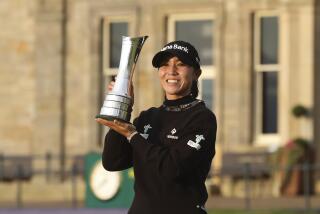Battler Royal
- Share via
When he plants his tee at the first hole of Royal Lytham, Gary Player will have reached another milestone in one of the most remarkable professional careers of all time--his 46th British Open.
Not only is Player the only golfer of the 20th century to have won the British Open in three decades, he is also the only player to have played it in six decades.
And now, at 65, he’s back at Lytham for the eighth time since he made his first appearance at the slightly oddball layout along the Lancashire coast in 1958.
If there is anyone who knows Lytham, it’s Player.
There is much with which to become acquainted. From that cute little rail line, the Lancashire and Yorkshire Railway, that hugs the right side of the course . . . to the ninth hole with the red brick houses at the back of the green that inject a decidedly urban flavor into your typical sandy links golf . . . to the Bobby Jones plaque at the 17th hole from 1926, Royal Lytham & St. Annes settles comfortably into its own niche in the British Open rotation of courses.
Player won three Open championships, at Muirfield in 1959, at Carnoustie in 1968 and at Lytham in 1974. Only five golfers, Player among them, have won all four major championships. The others are Gene Sarazen, Ben Hogan, Jack Nicklaus and Tiger Woods.
Woods and Player are back playing Lytham this time, and if Woods is going to successfully defend the title he won a year ago at St. Andrews, he would do well to listen to Player’s knowledge of the course.
After all, it was Player who won there by four shots in 1974, closing out his victory with one of the most unusual ways to play the 72nd hole in history. On the other hand, considering that this was Lytham, maybe it wasn’t so unusual after all.
“I had a six-shot lead with two to go, which was very nice,” Player said.
“But my second shot from out of the rough flew up against the clubhouse.”
Standing in a flower bed and with a clubhouse full of people watching from the windows just above, Player’s only option was to turn the blade of his putter around and jab at the ball left-handed.
Give him credit for extemporaneous success. He won by four.
“The members were in there, having their drinks,” Player said. “I remember the club secretary had his head out the window to watch. I said, ‘Just hold our drinks for a second while I have this shot.’ ”
The shot belongs in Lytham’s history, which is rich with such examples of ingenious shotmaking.
In fact, two more of the most famous in all of golf occurred at Lytham. In 1926, Jones’ second shot from a sandy no-man’s land on the 17th hole on the last day landed two feet from the cup, the key shot in his victory over a justifiably shocked Al Watrous. In 1979, Seve Ballesteros knocked his tee shot on the 16th hole on Sunday into a parking lot next to a hospitality tent, where he took a free drop, pitched to the green and rolled in a 30-foot birdie putt to win by three shots.
The resourceful are often rewarded at Lytham, it would seem.
That was Bobby Locke’s story in the 1952 Open at Lytham, when he trailed Fred Daly by four shots after three rounds. That night, Locke put his clubs in the trunk of his car and parked it, but the garage was closed when Locke woke up. A milkman knew where the garage owner lived and Locke eventually retrieved his clubs, making it to the tee with just enough time to put on his shoes.
Lytham is a course where only the very strong, the very brave and the very thoughtful win out.
“The thing about Lytham that people get mistaken is that it’s a very, very well thought-out golf course,” Player said. “It’s extremely well-bunkered off the tee and around the green. To play well at Lytham, you have to do your homework.”
In that case, here is Player’s study sheet accompanying the holes:
More to Read
Go beyond the scoreboard
Get the latest on L.A.'s teams in the daily Sports Report newsletter.
You may occasionally receive promotional content from the Los Angeles Times.










